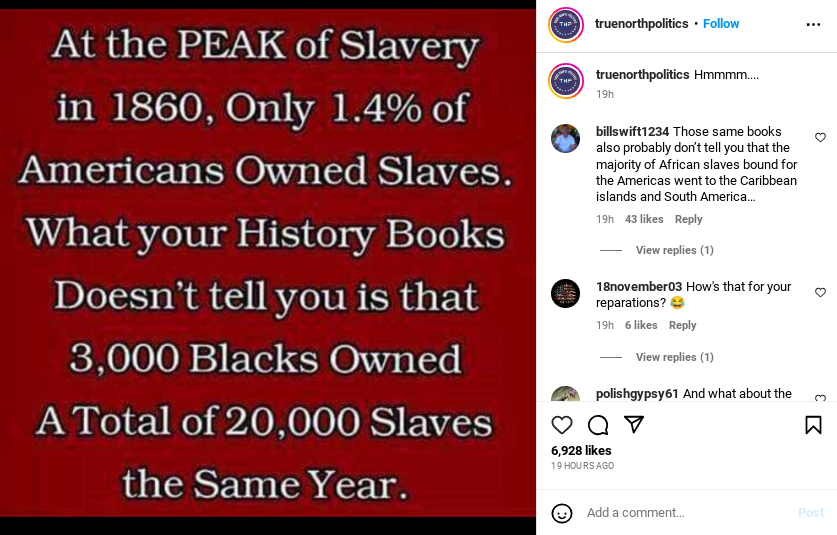
Does the idea that 1.4 percent of Americans owned slaves in 1860 represent the true extent of slavery at that time? No, that's not true: That statistic isn't meaningful. By 1860, slave ownership was concentrated in the southern U.S., making only the population in those states relevant to the issue of slave ownership. The population of the southern U.S. also is not the most accurate number in considering how many people may have benefited from slave labor.
The claim has circulated online since at least 2005. It reappeared in a post on July 11, 2023, on Instagram. The post included a graphic with text that opened:
At the PEAK of Slavery in 1860, Only 1.4% of Americans Owned Slaves.
The post included another statistic about Black slave owners that is out of the scope of this fact check.
This is how the post looked on Instagram at the time of writing:

(Source: Instagram screenshot taken on Wed Jul 12 14:17:35 2023 UTC)
Where did '1.4%' come from?
While the post did not cite a source, the 1860 U.S. Census is the most useful resource for determining U.S. population statistics during that year. According to the census numbers from 1860, the total U.S. population was about 31.4 million. Of that total population, around 3.9 million were enslaved, meaning that more than 27 million of the total U.S. population were considered free. That means that about 12.6 percent of the total U.S. population was enslaved.
Although some sources such as RootsWeb list the number of slave owners at more than 393,000, Lead Stories could not locate official numbers from the U.S. Census Bureau that corroborated that figure. But if that figure is to be trusted, then the number of slave owners compared to the total U.S. population of free people (around 27 million) is about 1.4 percent. Still, the total U.S. population of free people included children, a group that most likely would not have owned slaves. That in itself skews the relevance of the statistic.
Slavery, family and the South
The "1.4%" statistic also fails to consider that by 1860, slavery was only allowed in 15 of the 33 states in the country. So, another error in using the "1.4%" statistic is that it relies on the total U.S. population rather than the total population of states that allowed slavery and those states' slave owners.
But even using the slave-holding states' population figures would not be sufficient. It is more accurate to look at figures related to slave-owning families and households in slave-holding states. Those categories more accurately consider how slave labor would have benefited more than just individual slave owners.
William Darity, the Samuel DuBois Cook Professor of Public Policy, African and African American Studies, and Economics at Duke University, put family ownership of slaves in Southern states into perspective. In an email sent to Lead Stories on July 12, 2023, he called the claim "wholly misleading" and "dishonest." He also told us that family ownership of slaves was significant by 1860:
While 13 percent of white Americans nationally lived in slaveholding families, in Arkansas and Tennessee, one-quarter of whites lived in families that owned at least one slave. In Texas, Virginia, and North Carolina the percentage was at least one-third. It rose above 40 percent in Florida, Georgia, Alabama, and Louisiana, peaking at 55 and 57 percent in Mississippi and South Carolina.
According to the conclusion of "Soldiering in the Army of Northern Virginia: A Statistical Portrait of the Troops Who Served under Robert E. Lee," a book by Joseph T. Glatthaar, the Stephenson Distinguished Professor of History at the University of North Carolina at Chapel Hill, 24.9 percent of Southern households owned slaves in 1860.
Adam Goodheart, a historian at Washington College, told Lead Stories in an email sent on July 12, 2023, that "8% of American households (white and free black) owned slaves." He also used an example to illustrate how the "1.4%" statistic is, as he put it, "how to lie with statistics":
Here's a comparison: Let's say 10 families live on a certain block. Every family has 4 people in it, and every family owns one car. So could you say that because there are 40 people on the block, and 10 cars, 'only 25% of the residents on this block own cars'?
Slave labor benefited more than just slave owners
Still, such figures focused on families and households are not totally reflective of how slavery benefited free people in slave-holding states.
Robert Gudmestad, professor and chair of the Department of History at Colorado State University, said to Lead Stories in an email sent on July 12, 2023, that "The claim is misleading and is probably meant to minimize the influence of slavery in American History." He told us in a follow-up email sent the same day that "the influence of slavery went way beyond the ownership of enslaved people":
Businesses that did not own enslaved people earned profits from slavery and many of them were in northern states where slavery was illegal. Insurance companies made money from slavery because they insured enslaved people. Banks made money from slavery because they loaned money to people to buy enslaved people. American factories where cotton was spun into thread and clothing made money from slavery because enslaved people produced cotton. Slave traders transported enslaved people on railroads and steamboats, thus providing revenue to those entities.
Gudmestad also told Lead Stories that the rental of enslaved people was another business model that reinforced slavery.
In an email sent to Lead Stories on July 12, 2023, Glatthaar from the University of North Carolina at Chapel Hill also stressed the importance of slavery to non-slave-owners:
Keep in mind that in most instances the father was listed as the slave owner, not the wife or both. Their children lived as clear beneficiaries of slave production. Slaveholders loaned slaves to neighbors in need, so slave production spread wider than the owner. Also, slaves produced a disproportionate amount of the cash crops such as cotton (75%), tobacco, rice, and sugar. Larger slaveholders concentrated on producing cash crops, and this enabled small (yeoman) farmers to sell foodstuffs to planters, thereby providing an easy market for their crops.
Lead Stories fact checks about slavery
Other Lead Stories fact checks about slavery include one debunking the claim that President Joe Biden's great-grandfather owned slaves and fought for the Confederacy (here) and one debunking the claim that an image showed a Black Friday slave auction in 1904 (here).














